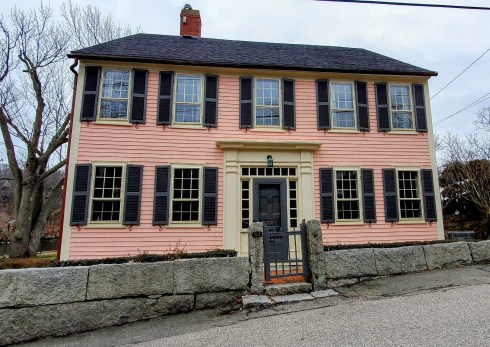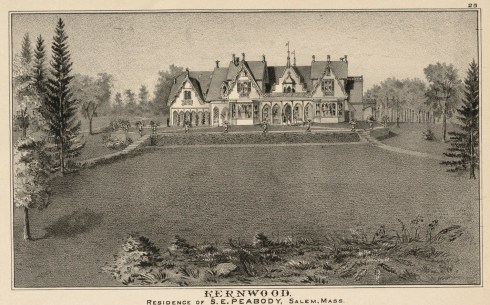I feel like I should know more about Gloucester, the port city about a half hour to the north of Salem. I have quite a few Salem friends who have summer homes in Gloucester, or have moved to Gloucester, or just go to Gloucester often: it’s like an escape hatch of sorts. 2023 marks Gloucester’s 400th Anniversary, and I have been super impressed with the city’s commemoration efforts: they are creative, comprehensive, and most importantly, expressions of the community rather than of a limited pool of “stakeholders,” as seems to be the case with Salem as it gears up to its 400th in 1626. I’ve been to Gloucester often, but I can’t even begin to characterize it as a place: it doesn’t seem like one city to me, but rather several. It’s certainly big: I decided to drive around in search of some of its earliest houses the other day and it took me all afternoon and I feel like I barely scratched the surface! I’m not even sure that I have the neighborhoods straight, to be honest: I started out in West Gloucester, then drove downtown, then to East Gloucester and Rocky Neck, then through Rockport to the northern side of Gloucester, stopping in Lanesville and Annisquam. Depending on where you are, you can find any style of house you want in Gloucester: big old shingled “cottages,” smaller cottages in a variety of styles, Greek Revivals, vast Victorians, stucco Craftsmans and even a Tudor or two. Not too many three-story Federals so prevalent in Salem, Newburyport, and Portsmouth: Gloucester was/is a fishing port so not as many wealthy merchants. I was looking for Colonials on this little expedition, the older the better, so that determined my route. Unfortunately, I forgot my sources: Prudence Paine Fish’s excellent books on Gloucester’s old houses (Ms. Fish died recently; a great loss for Gloucester) and Edwin Whitefield’s Homes of our Forefathers. On my own I missed quite a bit of this sprawling old city with its innumerable inlets so expect return trips over the next year or so!

I started out in West Gloucester where I drove way out along Concord Street: in my experience streets named for other Massachusetts towns have the oldest houses. At least part of the first house below, the Ella Proctor Herrick House, was built in the seventeenth century and the last one proudly bears a first-period plaque as well.



 Along Concord Street, West Gloucester.
Along Concord Street, West Gloucester.
Then I drove miles to downtown Gloucester, overlooking its expansive harbor. This is the most densely-settled area of the city, obviously, and also where you can find the most architectural variety. It’s also where the Cape Ann Museum (CAM) is, a museum of art and history which also owns and operates several house museums. Of course I’m jealous that Gloucester has a professional local museum, but CAM’s existence is just one of several indicators that Gloucester is serious about preserving and interpreting its heritage, material and textual: I also like the way older houses are interwoven with newer, professional and institutional structures in the city center. The first house below, on Middle Street, is wedged between a bank and some other professional office building, and has lots of Georgian neighbors.





 Along Middle Street, Gloucester.
Along Middle Street, Gloucester.
On the way to the Green, where CAM owns and operates two historic houses, I passed by this first cute and very characteristic of Gloucester house and one of the city’s oldest houses, the Whittemore House (1700), now a frame shop. The Green, situated right on Gloucester’s traffic rotary on Route 128, features three historic structures (the White Ellery House, 1710 and the Babson-Alling House, 1740 are below) and CAM’s newest exhibition space, the Janet & William Ellery James Center (2020), which has expanded the museum’s exhibition and archival space signficantly.




I hopped right on the rotary and drove to East Gloucester, which was a pass-through for me as I didn’t have my sources! So I did the Cape Ann loop, enjoying the views and driving through Rockport, and ended up in Lanesville and Annisquam on Gloucester’s northern shore. As you can tell from these photographs, it was a cloudy, dreary day (as has been the case for most of January in our parts) and so I had to snap this bright orange cottage in Lanesville and then it was on to Annisquam, which is really almost too precious and perfect (and with too many “private drives”!) but I had to see the Edward Harraden House (c. 1660)—one of several structures built by this family in Gloucester. It’s a storied name in Salem too as Jonathan Harraden was one of our most famous revolutionary privateers. It did not disappoint.



 Eighteenth-century houses in the Lanesville (ORANGE!) and Annisquam villages of Gloucester, and the Edward Harraden House, c. 1660.
Eighteenth-century houses in the Lanesville (ORANGE!) and Annisquam villages of Gloucester, and the Edward Harraden House, c. 1660.











 The names of just one day’s (September 22) victims of the Salem Witch Trials reveal some extent of the regional impact, but the University of Virginia’s site has a dynamic regional map
The names of just one day’s (September 22) victims of the Salem Witch Trials reveal some extent of the regional impact, but the University of Virginia’s site has a dynamic regional map 


 I can’t find a single contemporary (or later) image of Saltonstall–only mistaken images of his grandfather and son, but Sidney Perley included his autograph in his History of Salem (1924); Saltonstall family crest, Cowan’s Auctions.
I can’t find a single contemporary (or later) image of Saltonstall–only mistaken images of his grandfather and son, but Sidney Perley included his autograph in his History of Salem (1924); Saltonstall family crest, Cowan’s Auctions.















 The Kittredge Mansion & gate in HABS photographs from 1940-41, Library of Congress.
The Kittredge Mansion & gate in HABS photographs from 1940-41, Library of Congress.
















































